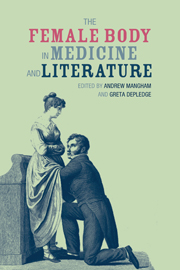Book contents
- Frontmatter
- Contents
- Acknowledgments
- Notes on Contributors
- 1 Introduction
- 2 ‘Difficulties, at present in no Degree clear'd up’: The Controversial Mother, 1600–1800
- 3 Monstrous Issues: The Uterus as Riddle in Early Modern Medical Texts
- 4 Surveilling the Secrets of the Female Body: The Contest for Reproductive Authority in the Popular Press of the Seventeenth Century
- 5 ‘Made in Imitation of Real Women and Children’: Obstetrical Machines in Eighteenth-Century Britain
- 6 Transcending the Sexed Body: Reason, Sympathy, and ‘Thinking Machines’ in the Debates over Male Midwifery
- 7 Emma Martin and the Manhandled Womb in Early Victorian England
- 8 Narrating the Victorian Vagina: Charlotte Brontë and the Masturbating Woman
- 9 ‘Those Parts Peculiar to Her Organization’: Some Observations on the History of Pelvimetry, a Nearly Forgotten Obstetric Subspeciality
- 10 ‘She read on more eagerly, almost breathlessly’: Mary Elizabeth Braddon's Challenge to Medical Depictions of Female Masturbation in The Doctor's Wife
- 11 Mrs Robinson's ‘Day-book of Iniquity’: Reading Bodies of/and Evidence in the Context of the 1858 Medical Reform Act
- 12 Rebecca's Womb: Irony and Gynaecology in Rebecca
- 13 Representations of Illegal Abortionists in England, 1900–1967
- 14 Afterword: Reading History as/and Vision
- Index
12 - Rebecca's Womb: Irony and Gynaecology in Rebecca
- Frontmatter
- Contents
- Acknowledgments
- Notes on Contributors
- 1 Introduction
- 2 ‘Difficulties, at present in no Degree clear'd up’: The Controversial Mother, 1600–1800
- 3 Monstrous Issues: The Uterus as Riddle in Early Modern Medical Texts
- 4 Surveilling the Secrets of the Female Body: The Contest for Reproductive Authority in the Popular Press of the Seventeenth Century
- 5 ‘Made in Imitation of Real Women and Children’: Obstetrical Machines in Eighteenth-Century Britain
- 6 Transcending the Sexed Body: Reason, Sympathy, and ‘Thinking Machines’ in the Debates over Male Midwifery
- 7 Emma Martin and the Manhandled Womb in Early Victorian England
- 8 Narrating the Victorian Vagina: Charlotte Brontë and the Masturbating Woman
- 9 ‘Those Parts Peculiar to Her Organization’: Some Observations on the History of Pelvimetry, a Nearly Forgotten Obstetric Subspeciality
- 10 ‘She read on more eagerly, almost breathlessly’: Mary Elizabeth Braddon's Challenge to Medical Depictions of Female Masturbation in The Doctor's Wife
- 11 Mrs Robinson's ‘Day-book of Iniquity’: Reading Bodies of/and Evidence in the Context of the 1858 Medical Reform Act
- 12 Rebecca's Womb: Irony and Gynaecology in Rebecca
- 13 Representations of Illegal Abortionists in England, 1900–1967
- 14 Afterword: Reading History as/and Vision
- Index
Summary
Daphne du Maurier's Rebecca (1938) radiates contempt for most ‘types’ and for both sexes, but it seems to reserve particularly harsh judgement for women. Like its literary antecedent Jane Eyre, the fairytale heroine triumphs at the expense of every other woman in the novel. These women are at best caricatured and at worst condemned, often aligned with sinister, perverse connotation. From the loathsome vulgarian Mrs Van Hopper to the hideous Mrs Danvers, female presence is regarded in this novel as a threat, a dangerous encounter requiring ruthless counter-tactics and survival strategies. In no character is this dangerous horror surrounding femaleness more acutely realized than in the snake-like, subversive Rebecca, and her danger is echoed in nuanced terms in the voice of the storytelling narrator herself.
The question is, though, why would a female novelist write women in this way? So frequently dismissed as a Gothic ‘romance’, that death knell to literary pretension in women's writing, Rebecca is, as feminist critics have been constantly aware, a rather more complex affair in its occupation of liminal territories relating to psycho-sexual desire and patriarchal relationships, and in its narrative tactics that call into question issues of subjectivity, identity, and readerly tactics. Less emphasized in critical discussion, but no less crucial to this text's meaning, is the comment passed within it on an old order in its death throes. Written in 1938 on the eve of war, but set in 1931, Rebecca is a ‘memory text’ that expresses nostalgia for a world of class privilege, excess, and splendour, but that also celebrates its demise.
- Type
- Chapter
- Information
- The Female Body in Medicine and Literature , pp. 182 - 195Publisher: Liverpool University PressPrint publication year: 2011
- 1
- Cited by

